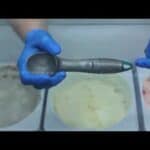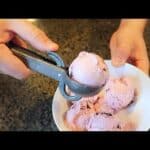Remember those summer days when your family would pile into the car, go to the soda shop, and watch the ice cream magicians scoop the perfect dollop of ice cream onto an ice cream cone? Here are some great news for you: now you can make your family’s ice cream magical! Check out the steps below to learn how to scoop the perfect cone!
How To Scoop Ice Cream
Tip 1: Consider Consistency and Temperature.
High sugar content won’t freeze as much as less sugary ice creams. Before scooping, Dennis lightly runs his scooper down the middle of the carton. “If it’s really soft, I need to use less force because the scoop goes deeper and it won’t come out in a perfect scoop,” he says.
For home scoopers, Dennis recommends poking a spoon into your pint. “If the spoon goes in easily, you should scoop with less pressure. The more pressure you put in soft ice cream, [the more it] makes it melt every time you scoop.” On the opposite end, sorbets and low-sugar ice creams can get rock hard in the freezer. Dennis has a simple fix: To bring sorbet and ice cream to a scoopable temperature, most pints only need two minutes on the counter.
Tip 2: Keep Water Handy.
Dip your ice cream scoop in room temperature water to keep frozen desserts from sticking to metal scoops, making them easier to deposit into cups and cones. We have Reviews for the best ice cream scoop, in case you are looking for recommendation
Tip 3: Don’t Scoop Down.
While it seems counterintuitive, you will never scoop the perfect scoop if you work straight down. There won’t be a full rotation, and the sides of the scoop will be messy. To form your sphere, scoop around the edges of the container, using the walls as reinforcement.
Dennis dips the scoop slightly further down the edges of pint containers than he does at Ice and Vice, then works his way around 3/4 or a complete rotation. Before removing the sphere from the container, he dips his scoop in water one more time, then works it under the sphere and lifts it. This prevents the sphere from sticking to metals and containers.
Tip 4: You Need a Solid Base.
Konery waffle cones are used at Ice and Vice since they have a back on which to rest scoops. On sugar cones, however, you can create impressive scoops. “Definitely consider the ice cream consistency and put the harder ice cream on the bottom. As you add more scoops, the softer ice cream will sink in.” Getting scoops to stick in a sugar cone requires some pressure. “I’d recommend using about 25 percent of your maximum force when putting it on the cone, and then less pressure as you put second and third scoops.” If you don’t have a cone holder, Dennis suggests using the top of an empty, clean milk jug.
Tip 5: Use Some Elbow Grease.
Dennis trains employees at Ice and Vice to scoop with their shoulders and elbows, rather than their wrists. It uses less energy and reduces the risk of injury. It’s a big muscle in your shoulder, he says. “I rotate my entire arm forward without moving my wrist.”
Tip 6: Get Your Scoop Ready for the Next.
Using the back of the scooper, create a light imprint for the next scoop to sit in to prevent it from rocking or tilting.
Tip 7: You Aren’t Stuck with a Messy Scoop.
It’s a common mistake for employees to continue building after a messy first scoop. As you work the scoop, it becomes less moist and water no longer separates the ice cream from the metal. When the scoop isn’t perfect, Dennis dips his scooper back into water to reshape and smooth it again.
Ice Cream & Friends offers more ice cream recipes, tips, and tricks for when things go wrong, including pops, gelato, milkshakes, sprinkles, cones, and so much more.
Was this helpful?
Hi there! I’m a food enthusiast and journalist, and I have a real passion for food that goes beyond the kitchen. I love my dream job and I’m lucky enough to be able to share my knowledge with readers of several large media outlets. My specialty is writing engaging food-related content, and I take pride in being able to connect with my audience. I’m known for my creativity in the kitchen, and I’m confident that I can be the perfect guide for anyone looking to take their culinary journey to the next level.








